
Tamerton Foliot is a village and former civil parish situated in the north of Plymouth, in the Plymouth district, in the ceremonial county of Devon, England. It also lends its name to the ecclesiastical parish of the same name.

East Allington is a village and civil parish in the South Hams district of Devon, England, three miles (5 km) south of Halwell and just off the A381 road. It lies about three miles (5 km) from Kingsbridge and about ten miles (16 km) from Totnes. The coast at Slapton Sands is about five miles (8 km) to the south-east. Also in the parish is the hamlet of The Mounts, about one mile (1.6 km) away.
Bowden is a historic estate in the parish of Yealmpton in Devon, England. From the 15th century until 1748 the manor house was for eight generations the seat of a junior branch of the Copleston family of Copplestone. The manor house was largely rebuilt in the 19th century and, together with some of its outbuildings, now serves as a farmhouse.

Sir William Fortescue, of Buckland Filleigh, Devon, was a British judge and Master of the Rolls 1741–1749.
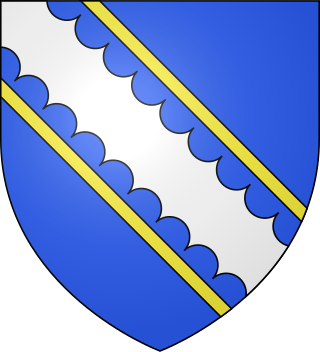
Sir Faithful Fortescue (1585–1666), of Dromiskin in County Louth, Ireland, was Governor of Carrickfergus in Ireland, long the chief seat and garrison of the English in Ulster and was a royalist commander during the English Civil War.

Weare Giffard is a small village, civil parish and former manor in the Torridge district, in north Devon, England. The church and manor house are situated 2 1/2 miles NW of Great Torrington in Devon. Most of the houses within the parish are situated some 1/2-mile east of the church. The church is situated on a hillside to the north and slightly above the wide and flat valley floor of the River Torridge. The Church of the Holy Trinity and the adjacent Weare Giffard Hall are designated members of the Grade I listed buildings in Devon. In 2011 the parish had a population of 345.

Heanton Satchville was a historic manor in the parish of Petrockstowe, North Devon, England. With origins in the Domesday manor of Hantone, it was first recorded as belonging to the Yeo family in the mid-14th century and was then owned successively by the Rolle, Walpole and Trefusis families. The mansion house was destroyed by fire in 1795. In 1812 Lord Clinton purchased the manor and mansion of nearby Huish, renamed it Heanton Satchville, and made it his seat. The nearly-forgotten house was featured in the 2005 edition of Rosemary Lauder's "Vanished Houses of North Devon". A farmhouse now occupies the former stable block with a large tractor shed where the house once stood. The political power-base of the Rolle family of Heanton Satchville was the pocket borough seat of Callington in Cornwall, acquired in 1601 when Robert Rolle purchased the manor of Callington.
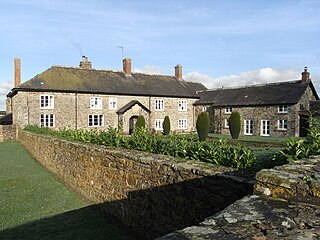
Brightley was historically the principal secondary estate within the parish and former manor of Chittlehampton in the county of Devon, England, situated about 2 1/4 miles south-west of the church and on a hillside above the River Taw. From the early 16th century to 1715 it was the seat of the Giffard family, whose mansion house occupied the moated site immediately to the west of the present large farmhouse known as Brightley Barton, a Grade II listed building which incorporates some elements of the earlier house. It is not to be confused with the 12th-century Brightley Priory near Okehampton.

The landed gentry and nobility of Devonshire, like the rest of the English and European gentry, bore heraldic arms from the start of the age of heraldry circa 1200–1215. The fashion for the display of heraldry ceased about the end of the Victorian era (1901) by which time most of the ancient arms-bearing families of Devonshire had died out, moved away or parted with their landed estates.

The estate of Acland in the parish of Landkey, near Barnstaple in North Devon, England, was from 1155 the earliest known seat of the influential and wealthy family of Acland, to which it gave the surname de Acland. It is situated about 3/4 mile north-east of the village of Landkey, from which it is now cut off by the busy A361 North Devon Link Road.

Newnham in the parish of Plympton St Mary in Devon is a historic estate long held by the Devonshire gentry family of Strode. The ancient mansion house is situated 1 mile north-east of St Mary's Church, beside the Smallhanger Brook, a tributary of the Tory Brook, itself flowing into the River Plym. The house was abandoned by the Strode family in about 1700 when they built a new mansion on the site of Loughtor Manor House, about 1/3 mile to the north-east of Old Newnham.
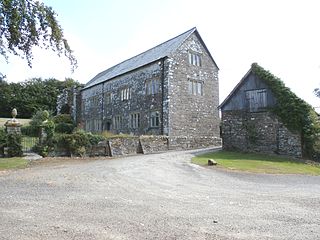
Bremridge is a historic estate within the former hundred of South Molton in Devon, England. It is now within the parish of Filleigh but was formerly in that of South Molton. It is situated 8 miles north-west of South Molton. Since the construction of the nearby A361 North Devon Link Road direct access has been cut off from Bremridge to Filleigh and South Molton. The surviving wing of the mansion house built in 1654 is a Grade II* listed building. Bremridge Wood is the site of an Iron Age enclosure or hill fort, the earthwork of which is situated on a hillside forming a promontory above the River Bray. In Bremridge Wood survives a disused tunnel of the former Great Western Railway line between South Molton and Barnstaple, much of the course of which has been used for the A361. The tunnel is 319 yards long and was identified as "Bremridge Tunnel" in the 1889 Ordnance Survey map but as "Castle Hill Tunnel" in subsequent editions.

Ash in the parish of Musbury in the county of Devon is an historic estate, long the residence of the ancient Drake family, the heir of which remarkably was always called John, only one excepted, for ten generations. It was formerly believed to have been the birthplace of John Churchill, 1st Duke of Marlborough (1650–1722), whose mother was Elizabeth Drake, but was in fact probably in ruins at the time of his birth. The future Duke was however baptised in 1650 in the Chapel at Ash, which had been licensed by the Bishop of Exeter in 1387. Ash was "burnt and demolished" during the Civil War and "lay long in ruins" during which time the family moved one mile away to Trill, Axminster. John Drake (1625–1669), the wartime occupant who had suffered so greatly for the Royalist cause received some recompense at the end of the troubles by being created a baronet by King Charles II on the Restoration of the Monarchy in 1660. Ash was rebuilt "to a greater perfection than it was of before" by Sir John Drake, 2nd Baronet (1647–1684). The last in the male line was Sir William Drake, 6th Baronet, who died without children and bequeathed all his estates to his widow Anne Williams, who remarried to George Speke, MP, and had by him a daughter Anne Speke, who brought the Drake estates, including Ash and the advowson of Musbury, to her husband Frederick North, 2nd Earl of Guilford (1732–1792), who sold them piece-meal to various persons. Ash House survives today as a grade II* listed private residence in much the same form as depicted by Swete in 1795.

Whympston in the parish of Modbury in Devon, England, was a historic manor that belonged to the Fortescue family.

Warleigh is a historic estate within the parish of Bickleigh in Devon, about 6 miles from Plymouth. Warleigh House, the manor house of the manor of Tamerton Foliot is situated one mile west of that village on the south-east bank of the River Tavy where it joins the River Tamar. It was remodelled in about 1830 in the Gothic style by John Foulston and has been listed Grade II* on the National Heritage List for England since 1960.

Soldon in the parish of Holsworthy Hamlets, Devon, England, is a historic estate, a seat of the Prideaux family. The manor house is a grade II listed building dating from the mid-16th century with later alterations. It was sold in 2014 as an eight bedroomed house with an acre and a half of grounds for an asking price of £750,000.

Orcheton is an historic estate in the parish of Modbury in Devon. The present house, known as Great Orcheton Farm is situated 1+1⁄2 miles south-west of Modbury Church.

Painsford is an historic estate in the parish of Ashprington in Devon.
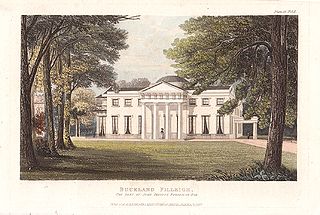
The manor of Buckland Filleigh was a manor in the parish of Buckland Filleigh in North Devon, England. Mentioned in the Domesday Book, the manor and its estates passed through several families, including over 300 years owned by the Fortescues.
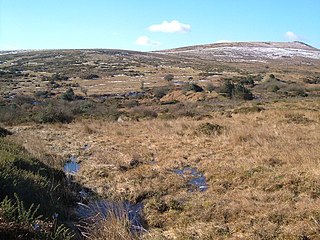
Bagtor is a historic estate in the parish of Ilsington in Devon, England. It was the birthplace of John Ford the playwright and poet. The Elizabethan mansion of the Ford family survives today at Bagtor as the service wing of a later house appended in about 1700.





























